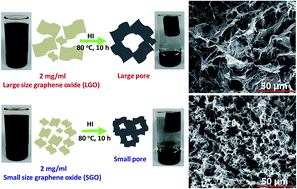Tuneable cellular-structured 3D graphene aerogel and its effect on electromagnetic interference shielding performance and mechanical properties of epoxy composites†
Abstract
Microstructure design is a crucial factor in determining the performances of graphene/polymer composites. In this study, controllable cellular-structured graphene aerogel–epoxy composites (GA–EP) were fabricated by an infiltration method using porous GA as a framework; GA with different pore sizes and morphologies was tuned by employing precursor graphene oxide (GO) sheets with varied sizes. The structural morphology, electromagnetic interference shielding (EMI) performance and mechanical properties as well as the thermal stability of GA–EP composites were comprehensively and comparatively investigated. It was found that GA which originated from large-sized GO sheets after compounding with epoxy (LGA–EP) possesses superior EMI properties and compressive strength than those of GA assembled by small-sized GO sheets after integrating with epoxy (SGA–EP). LGA–EP with a thickness of 3 mm and loaded with ∼1.0 wt% filler exhibits an EMI shielding effectiveness of around 30 dB in the measured frequency range of 10–20 GHz and compressive strength of 56.01 ± 1.57 MPa. Both SGA–EP and LGA–EP exhibit excellent electrical conductivity, while the interconnected network with large graphene sheets in LGA–EP provides more effective and fast channels for electron transport than that of SGA–EP. The electrical conductivity of LGA–EP is up to 9.28 S m−1 at only 1.0 wt% filler content. On the contrary, SGA–EP can obtain a higher storage modulus, glass transition temperature and thermal stability than those of LGA–EP. These results indicate that the macro-properties including EMI shielding, conductivity and mechanical properties of GA–polymer composites can be tailored by using precursor GO sheets with different sizes, and the GA–EP composites with excellent EMI performance have great potential applications in various fields such as electronics, automobiles and aircraft.


 Please wait while we load your content...
Please wait while we load your content...